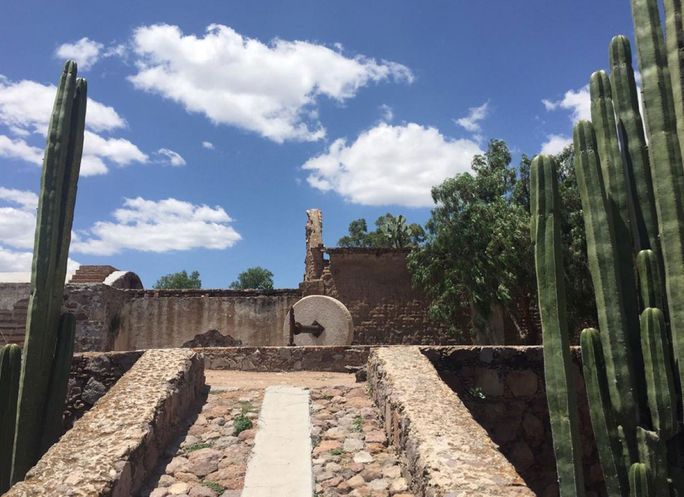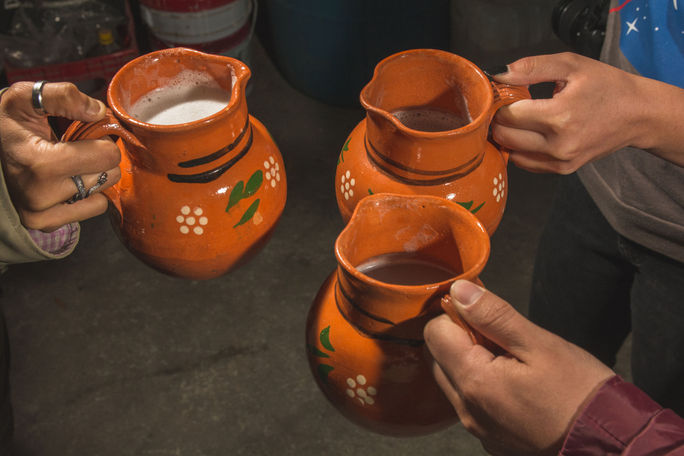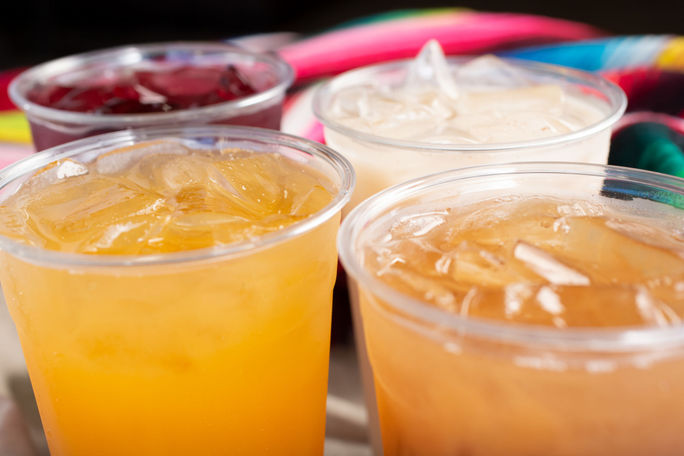Tequila and mezcal are drunk in a caballito, a special glass for these Mexican drinks. Pulque and tepache can be drunk in a beer mug, and aguas frescas (flavored fresh waters) in a traditional glass.
However, we invite you to visit the places where these five standard Mexican drinks are prepared.
Tequila
Originally from the blue fields of Jalisco, tequila is one of the most typical traditional drinks and has brought worldwide fame to Mexico. It has become one of the great ambassadors of Mexican culture.
Considered by many to be one of the best manufactured alcoholic beverage in the world, tequila has a production process��with stringent quality standards��almost as interesting as its flavor.
Tequila is obtained from the fermentation with yeast and distillation of the blue agave juices from the cooking of the agave heads. These heads have between six and 10 years of maturation. Subsequently, they are placed in wooden barrels.
Tequila began to be produced in the mid-17th century in a hacienda called Cuisillo, and today, there are around 160 brands and 12 haciendas that make it, giving life to one of the most demanded Mexican products abroad, which has the prestigious label of denomination of origin.
The town where it was born bears its name and is a charming Magic Town that, among agave landscapes, mariachis, and provincial airs, keeps legends and the secret of this mystical drink. Visiting its quiet corners, you will find the National Tequila Museum, the Templo de la Pur��sima, the Quinta Sauza, and the extinguished Tequila Volcano.
In addition, as the production of this liquor is the area's main attraction, the Tequila Express Route was created, a train ride in which you can see archaeological sites, old mansions, and especially the beautiful fields where the agave is grown.
This legendary drink contains its unique taste and smells of the pre-Hispanic past, the tradition of a mestizo people, and an elaboration process that resembles a work of art. Undoubtedly, it is an authentic "gift from the gods."
Mezcal

The Mezcal Route in Guanajuato, Mexico. (photo via Guanajuato) ((photo via Guanajuato))
Legend has it that a thunderbolt struck an agave plant, opening and cooking its center. From afar, the natives perceived the penetrating aroma of the nectar that emanated and drank with fear the liquid, a gift from their deities.
Thus, according to the myth, mezcal was born, perhaps Mexico's second most representative drink, which received the connotation of "coming from heaven."
It was not until the 16th century (when the Spaniards introduced the distillation process, a legacy of the Arabs) that distilled alcohol began to be produced and drunk in Mexico. Among them, tequila, aguardiente, and mezcal stand out.
Mezcal is the most produced in the country because any place where agaves are grown is ideal for its production. Thanks to this, different types of mezcal are made depending on the maguey, the climate, the distillation techniques, and the container used for fermentation.
The best known is the one from Oaxaca, where the mezcal tradition is said to have originated. It is served in its original presentation: a black clay container supported by a basket.
Although this drink also emerged as a traditional medicine, it has been endowed with a religious and ritual character throughout history. It is also an essential delicacy in the festivities of many of the country's indigenous peoples. It is served in hierarchical order in these communities and cannot be refused. Undoubtedly, it is a liquid tradition that no Mexican or foreigner can fail to try.
Pulque
The tradition and mystique surrounding pulque or octli (name in Nahuatl, a pre-Hispanic dialect) comes from the mythology of pre-Hispanic times. This white-colored liquid with a rough taste was considered a religious delicacy. However, it could only be consumed by people over 52 and on special occasions.

Group of friends enjoying pulque. (Photo Credit: Marco Ortiz/iStock/Getty Images Plus)
The myth describes that the tlacuache was also the one who gave men the secret of making pulque. Known as the first drunkard, the tlacuache discovered the effects of fermented mead and taught humankind how to prepare it.
In Aztec cosmogony, Tezcatz��ncatl was the god of wine (or pulque), who had 400 priests consecrated to him.
Pulque is made from the fermentation of the maguey heart or aguamiel through a process known as "raspado." This process is carried out by a "tlachiquero." When the maguey reaches a certain age, the core is removed. Only a hollow that will be scraped with an acocote��a kind of spoon��is left. In this way, it will release the sweet juice.
The juice concentrates in the hollow and is absorbed. Little by little, the juice is deposited in a vessel until it ferments in less than 24 hours. Pulque was so crucial during the Conquest that the taxes collected from its sale and production were one of the pillars of the colonial economy.
Today, this beverage is still produced, mainly in Hidalgo. Here, the rites and ceremonies of the ancient settlers are still performed when a plant has mead for the first time.
Currently, pulque is one of the most consumed traditional beverages in rural communities that preserve the maguey plantations. These were left to them as an inheritance from their ancestors, and the pulque produced in Apan is the most famous in the country.
Since colonial times, this drink has been sold and consumed in pulquer��as. These places have been part of the descriptions of costumbristas and historians who relate the folklore and tradition surrounding this drink. It should not be forgotten that, in the past, it was a pleasure only enjoyed by older adults.
The Flavored Waters
Aguas frescas have become the most famous traditional non-alcoholic beverages consumed in some scorching places. For this reason, street stalls and places where these drinks are offered abound throughout the country.

Aguas frescas. (Photo Credit: Photography By Tonelson/iStock/Getty Images Plus)
These waters are usually made from the seeds of different fruits and sometimes sweetened with sugar. The best known are those made from chia, hibiscus, horchata, and tamarind. While chia is a native seed, the other fruits are native to other regions of the world.
For example, the tamarind is native to India, while the hibiscus flower leaves come from tropical Africa. Horchata, prepared with rice, vanilla, and cinnamon in Mexico, was first used in Valencia, Spain.
However, how they are prepared, served��in the vast glass or plastic jugs standard in any dining room and taqueria��and consumed is pure of the country and is part of the daily diet and a tradition cherished by all Mexicans.
Tepache
This drink of penetrating flavor, produced from the fermentation of the sugars of some fruit��especially pineapple��is one of the favorite traditional beverages.
The word tepache comes from the Nahuatl "capital," a word that means corn drink because, previously��and currently in some indigenous communities��it was made from the fermentation of the mass of this cereal in water and was even used for some Mayan cults.

Fermented mexican pineapple Tepache. (photo via sveta_zarzamora /iStock / Getty Images Plus)
In the north of Mexico, it is known as "tesg��ino," which is used for religious purposes by the Rar��muri or Tarahumara. At the same time, in the south, it is called pozole, recognized for its medicinal properties.
The preparation of tepache requires four days. In the first two days, pieces of pulp and pineapple peel are left to rest in a clay pot with cloves and cinnamon. Then a mixture of barley and piloncillo, previously boiled, is added and left to ferment for another two days.
Although it is a ubiquitous drink in Mexico City, it is also widely consumed, although with some variations, in Jalisco, Nayarit, San Luis Potos��, Puebla, Morelos, Oaxaca, and Veracruz.
The refreshing taste of tepache has become an essential ingredient in many states' festivals and regional fairs, mainly in central and southern Mexico, as it generally has a low alcoholic level and a unique flavor that you can't help but enjoy.
So now you know some of the secrets and traditions of some traditional Mexican beverages. Try them and visit their places of origin.
For the latest travel news, updates and deals, subscribe to the daily TravelPulse newsletter.
Topics From This Article to Explore